Have you seen that Gothic-looking font in German newspapers? On old German signs? Or in old genealogical records?
This is the typeface known as Fraktur. The font itself was commissioned by the Holy Roman Emperor Maximillian I in the early 1500s and survived until it was outlawed in 1941 by the Nazis, then replaced with more Latin-looking fonts.
Many American genealogists have some difficulty reading the font, but I was fortunate enough to have been born and raised in the town of Ephrata, Pennsylvania. Ephrata was founded in 1732 by a Pietist named Johann Konrad Beissel, who established a monastic community on the banks of the Cocalico Creek and had the Brothers and Sisters spend their days creating elaborate illuminated documents using Fraktur and creating a printshop where early continental American books and documents were reproduced.
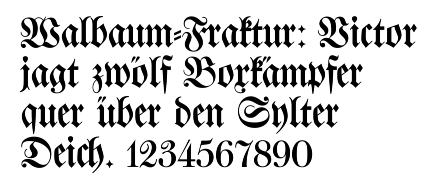
Pictured here is one of the many Fraktur documents created by the sisters of the Cloister. Notice that very little space is open, which demonstrates an artistic concept known as horror vacui, fear of empty spaces. It is a concept that is prevalent in German art of the time and traveled across the Atlantic. This was also prevalent in Pennsylvania Dutch Fraktur genealogical documents.
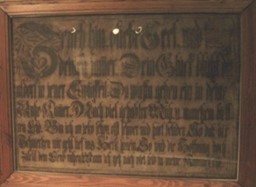
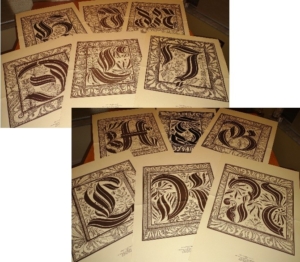
The Ephrata Cloisters were also known for their illuminated capital letters, as shown in the photograph of the ones printed at the Cloisters and for sale in the gift shop. Note that the horror vacui concept is at play in these illustrations.
As a young teenager, my best friend was very artistically talented and he convinced me to join him at the Cloisters for Fraktur lessons. And so I did! As a result, although my hand today isn’t nearly as steady as it once was, I can use the chisel point pen and write words in the font.
While the designs developed by the sisters of the Cloisters were of a religious nature, the Fraktur font and the concept of horror vacui generated a genre of art in the genealogical world of the 18th and 19th centuries. Events that modern-day genealogists record in their family trees, such as births, marriages, baptisms, and deaths, became the subject of very elaborate Fraktur art. Genealogists who have ancestors they are researching in Southeast Pennsylvania have surely discovered that many of their documents are highly decorated and often illustrated with the typical Pennsylvania Dutch bird (known as the Distelfink).
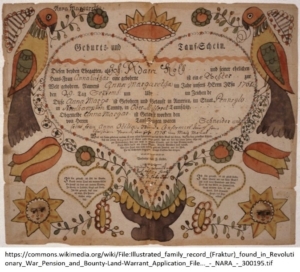
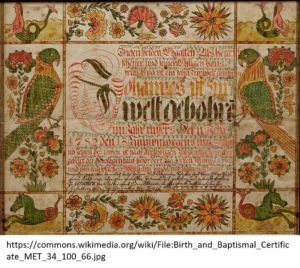
While I never became a genealogical Fraktur artist of any renown, I did create numerous Fraktur pieces of art. For friends, I duplicated and framed the Ephrata Cloister capital letters of their last names. When my wife and I got married forty years ago, I created a K and E that still hang over our bed today. I also dabbled with birth certificates, but obviously my art never compared with the likes of those I’ve displayed from real Pennsylvania Dutch Fraktur artists.
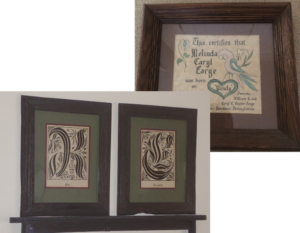
Since Fraktur became an art form, it is well represented in museums all throughout southeast Pennsylvania. You can see this in the family book found in the museum of the Cocalico Valley Historical Society in Ephrata, PA. Uniquely, it includes the sign of the Zodiac under which each child was born. But notice that even though there is relatively little reason to decorate it with a floral arrangement, as is typical with Pennsylvania Dutch Fraktur documents, it has ornamentation.
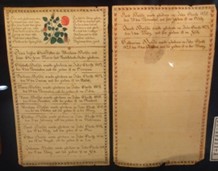
That being said, my involvement with German Fraktur art is limited by comparison to the various writers who have covered the topic over the years. I refer readers to Corinne and Earnest Russell who were residents of southeast Pennsylvania and published numerous volumes over the years on the topic of Fraktur. Some of their titles include: German-American Family Records in the Fraktur Tradition, Fraktur Folk Art and Family, and The Heart of the Taufschein. The relatively newly released book on Pennsylvania Dutch Fraktur comes from Lisa Minardi of the Philadelphia Museum of Art, entitled Drawn with Spirit-Pennsylvania Dutch Fraktur. Needless to say, museums all throughout southeast Pennsylvania are full of examples of genealogical documents written and illuminated in Fraktur.
If you have German ancestors who arrived in Philadelphia during the 1700s or even later, I encourage you to check out and visit the various museums throughout the region to view the numerous holdings they have, written and illuminated in Fraktur.
Please feel free to contact me about Fraktur and southeast Pennsylvania at [email protected].
(And just a Fraktur aside: When my high school German teacher wanted us to learn to read the font by using a German novella by the name of Immensee, I had no difficulty in doing so since I had been a student at the Ephrata Cloisters. Some of my classmates, however, struggled with the typeface. I really wasn’t wild about the storyline of Immensee, and couldn’t believe that I still had a copy of it when I unpacked boxes after our move to Florida. Before moving south, I gave most of my German books to German majors where I was teaching at the time, so I didn’t know why I had kept the volume. Lo and behold, when I opened the book, I found my grandfather’s signature and town of residence in his own handwriting! This version of the book was printed in 1908, about the same time that my grandfather was teaching at a small K-8 township school. My thinking is that he used the book to teach his students to read German, and Fraktur as well. Needless to say, I know why I kept the book!)
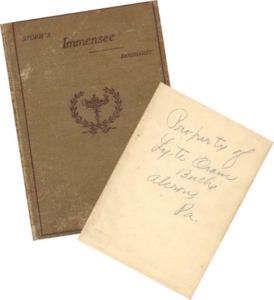
Check out other articles by Ken Weaver on Germanology Unlocked:
Wassersucht, Schwindsucht, und Altersschwäche: Researching Your Ancestor’s Demise
It’s All About Context: How Knowing What to Expect Will Help You With Your German Records
As a native Pennsylvania Dutchman, Ken Weaver can trace most every line of ancestors to an 18th century German or Swiss immigrant, so it was only natural that he learn to speak German and did so in high school under the tutelage of an inspiring immigrant German teacher. Majoring in German at Millersville University, he also studied at Philipps-Universität and upon graduation began a career as a German teacher. He went on to become a principal, but continued his language studies by earning certification in ESL. Upon retirement from the public education, he taught at the university level until recently moving to Florida. Now he works on his genealogy, and as a member of several different societies, spends considerable time teaching language tips to any genealogist who’ll listen! He can be reached at [email protected].
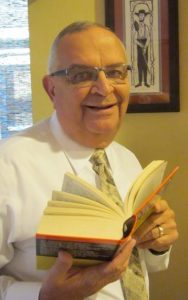

One Response
Hi,
Really enjoyed this article. What a treasure – to have a book with your grandfather’s signature plus home town! And to also think that he used that book for teaching – added “plus!”
Sandy